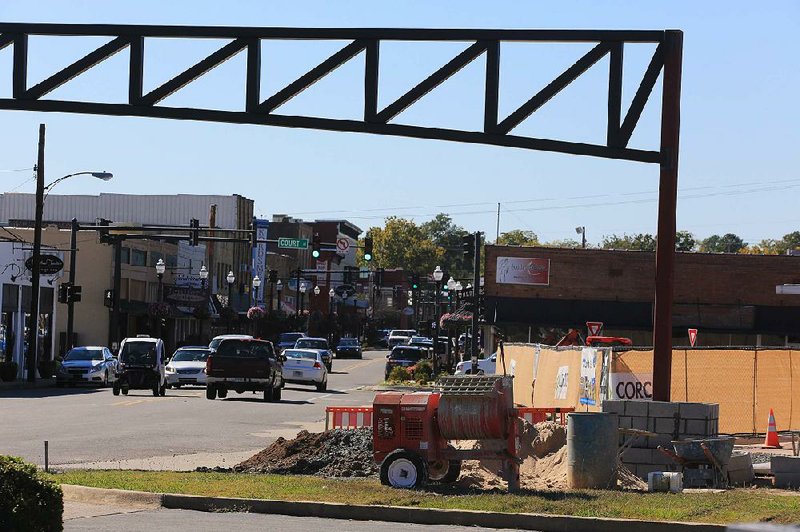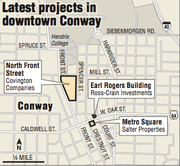Over the past decade, about $70 million in private and public dollars have been invested in downtown Conway, a figure that city leaders believe reflects the city’s reputation for diversity both in terms of its economy and residents.
“Our specialty, locally owned retail has tended to stay together in this downtown area,” said Brad Lacy, president and chief executive officer of the Conway Area Chamber of Commerce. “This gives us a leg up.”
As young professionals move into Conway, which “at its heart” is a college town, the downtown area is the only place that can operate on a 24-hour basis, Lacy said, making a strong downtown critical for the city’s future.
That willingness to invest in this city of 62,900 continued this month when three Conway-based developers talked about the latest projects aimed at adding to the downtown’s growth at the Conway Downtown Partnership’s annual meeting.
Salter Properties said it will expand its ongoing renovation of the 26,000 square-foot Regions Bank building at 1023 Main St., which it calls “Metro Square,” by adding a multifamily development of more than 60 units on the same lot, to be called the “Flats at Metro Square.”
Another project a block north, by Ross Crain Investments, will convert the 8,000-square-foot Earl Rogers Building at Oak and Van Ronkle streets into a mix of retail and restaurant space.
The third project, about two more blocks north of the Earl Rogers Building, will involve the development of five new buildings on a 6.5-acre parcel bounded by Front, Mill, Spencer and Smith streets for mixed use by the Covington Limited Family Partnership, LLC, a part of Covington Companies.
As these projects get underway, others are already in the works, including a new $509,000 gateway and archway, to be called “Rogers Plaza,” for vehicles traveling on Oak Street into downtown; an ongoing renovation of the former Bank of America branch into the corporate headquarters for Home Bancshares; and city efforts to develop a new streetscape plan for Markham Street from the downtown north toward Hendrix College using $50,000 in city funds and a $180,000 grant from Metroplan, the central Arkansas planning organization.
Lacy said the fact that downtown development is largely being done by Conway-based companies is a key reason why the city’s central business district keeps attracting investment.
One of those developers, George E. Covington Sr ., chairman of Covington Companies, said he and others understand the need to make a commitment to the community where they live.
“If you look at the downtowns that are still vibrant, it’s [because of the people who have] been there that have backed up and and said we realize this is not going to be a money-making, get-rich scheme deal,” said Covington, who is also chairman of the Downtown Partnership.
That means, he said, developers need to be patient.
“Ten years ago, there was nobody in downtown after 5 p.m,” Covington said. “Now, if you go to the downtown, sometimes it’s hard to find parking place. And that’s just a great feeling.”
His latest project - with an anticipated groundbreaking in the latter part of 2014, will be built in phases over the course of several years, with the company eventually investing between $15 million and $20 million as the project is built out.
“We’re going to do one building and fill it up and then, if we see how the project’s going then we’ll go from there,” Covington said. “We want to build it as we fill it up.”
Brent Salter, vice president of Salter Properties, agreed that a developer’s understanding of a market’s needs is key to the downtown’s evolution, but added that developers also need to have an eye toward the future.
Part of his project, Metro Square, includes 12,000 square feet of available office space, in addition to the Regions Bank branch. He said businesses considering a move to Conway are more interested in what’s available now than waiting a year or two for space to be built to meet their needs.
“If you don’t have the space, you can’t attract businesses,” Salter said.
At the same time, designs need to reflect the neighborhood and where the community sees its future, he said. Salter hesitated to put a price tag on the residential part of Metro Square, which he said could cost several million dollars. He said that portion of the project is still going through the approval process.
However, Salter said the Conway plan is similar to another he’s building in the Argenta district of downtown North Little Rock. Earlier this month, the company took out building permits for 78 housing units with a combined value of more than $5 million.
While his company is completing projects in other parts of the state, the Conway focus has worked, he said.
“If your investment dollars are creating the types of returns that you want where you’re at and you can improve the place where you live and where your kids live, why wouldn’t you do it?” Salter said.
The downtown projects follow on the heels of ongoing efforts by Hendrix College to develop its “Village at Hendrix” adjacent to the campus, as well as the newly announced “Central Landing” project - a $90 million proposal to repurpose the 150-acre city-owned airport. A new airport is being built on Conway’s outskirts.
Todd Ross, chief executive of Preferred Medical, who formed Ross Crain Investments with Chris Crain of Crain Automotive, acknowledges their project - currently involving a single building - is smaller than Covington’s and Salter’s.
He hopes that by late spring his building will be renovated at a cost of about $1 million and a new restaurant will fill the space at the entrance to downtown.
“Our building is not near as big and won’t have as much splash, if you will. It is in a neat spot,” Ross said. “But all three of them going on down there is an exciting time.”
Development in a downtown ebbs and flows, Ross said. But, renewed interest nationally among young people to move into urban settings where they can live and work is benefiting Conway, he said, as well as larger cities such as Little Rock and Fayetteville.
About 60 percent of the $70 million invested in Conway’s downtown came from public funds, said Kim Williams, executive director of the Conway Downtown Partnership.
Williams said the initial investment involved streetscape improvements: widening sidewalks, lighting, making intersections more pedestrian friendly. Later public investment included the construction of a new downtown police station. Those kinds of investments began attracting private dollars.
Ross said the ability of existing downtown business to succeed over several years is solidifying demand for the kinds of retail and other services being offered, creating a self-sustaining area of the city. Projects that add housing units will continue that kind of growth, he said.
TJ Johnston, executive vice president of the Chamber of Commerce and the Conway Development Corp., said the downtown area’s ability to keep operating as a retail center for locally-owned businesses has offset competition created by the growing presence of national low-cost retailers such as Wal-Mart and Target.
“Usually, retail is the last part” of a downtown revitalization effort, Johnston said. But changes such as allowing liquor by the drink at local restaurants - Faulkner County is one of Arkansas’ dry counties - and attitudes among younger people who want to live and work in an urban environment have helped spur interest, Johnston said.
Ross, Salter and Covington all agreed that their investments are just one facet of Conway’s economy.
Covington said developers from other parts of Arkansas and outside the state are expressing interest in projects in downtown Conway.
But, since Conway lacks tall buildings, there’s not much downtown apartment inventory - and most of what is available is full.
“People do want to walk to work,” Covington said. “That’s the kind of people we’re looking for: The people who work downtown, live downtown, go eat downtown.”
Business, Pages 68 on 10/27/2013


